The Foam Cups Market is estimated to be valued at USD 11.3 billion in 2025 and is projected to reach USD 14.9 billion by 2035, registering a compound annual growth rate (CAGR) of 2.8% over the forecast period.
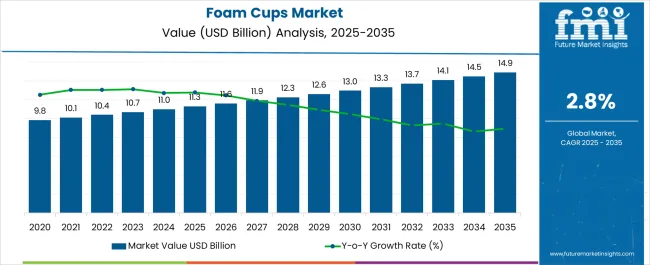
| Metric | Value |
|---|---|
| Foam Cups Market Estimated Value in (2025 E) | USD 11.3 billion |
| Foam Cups Market Forecast Value in (2035 F) | USD 14.9 billion |
| Forecast CAGR (2025 to 2035) | 2.8% |
The Foam Cups market is experiencing steady growth driven by increasing demand from foodservice outlets, retail chains, and household consumption. Growth is being supported by the convenience and cost-effectiveness of foam cups, particularly in fast-food, beverage, and takeaway sectors. Rising urbanization, the expansion of retail and convenience food chains, and increasing on-the-go consumption habits are influencing market expansion.
In addition, innovations in foam materials and enhanced insulation properties are improving the consumer experience by maintaining beverage temperature and reducing spills. The market outlook is further shaped by ongoing efforts to balance convenience with environmental considerations, prompting gradual adoption of recyclable or bio-based foams.
Distribution efficiency, ease of handling, and low production costs are also contributing factors that support continued demand As consumers increasingly seek convenient packaging solutions, foam cups are anticipated to remain a key product in both commercial and household applications, with growth potential across emerging and developed markets.
The foam cups market is segmented by size, cup type, sales channel, end user, and geographic regions. By size, foam cups market is divided into Up To 10 Oz, 10 To 16 Oz, 16 To 20 Oz, 20 To 32 Oz, and More Than 32 Oz. In terms of cup type, foam cups market is classified into Hot Cup Type and Cold Cup Type. Based on sales channel, foam cups market is segmented into Supermarket/Hypermarket, Departmental/Speciality/Discount Stores, Distributors, and Online Sales. By end user, foam cups market is segmented into Foodservice, Institutional, Household, and Catering Services. Regionally, the foam cups industry is classified into North America, Latin America, Western Europe, Eastern Europe, Balkan & Baltic Countries, Russia & Belarus, Central Asia, East Asia, South Asia & Pacific, and the Middle East & Africa.
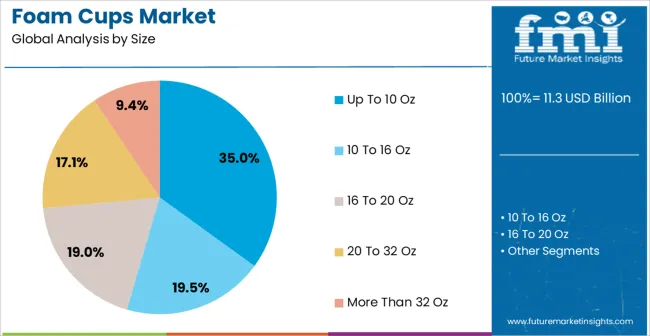
The Up To 10 Oz cup type is projected to hold 35.0% of the Foam Cups market revenue in 2025, making it the leading cup type segment. This predominance is being driven by its suitability for standard hot and cold beverages, particularly in fast-food chains, cafes, and convenience stores. The compact size allows for optimal portion control, reducing waste while meeting customer expectations for small servings.
Growth in this segment has also been supported by its compatibility with automated beverage dispensers and its lightweight design, which lowers shipping and handling costs. The Up To 10 Oz cups provide versatility in use across multiple beverage categories, including coffee, tea, and soft drinks, encouraging wider adoption.
Additionally, manufacturers are increasingly offering foam cups with improved insulation and spill-resistant designs, further solidifying demand The segment’s dominance is expected to continue as businesses prioritize operational efficiency, cost-effectiveness, and customer satisfaction in beverage service environments.
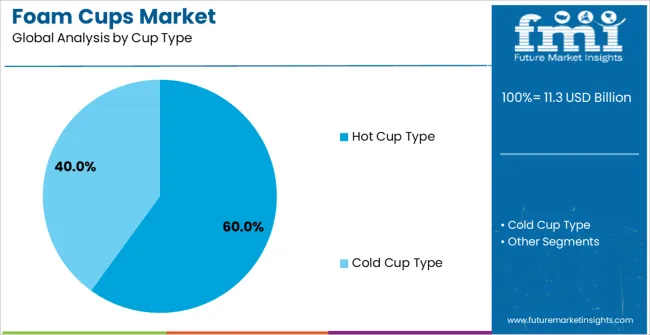
The Hot Cup Type segment is anticipated to hold 60.0% of the Foam Cups market revenue in 2025, positioning it as the leading application type. This growth is being fueled by the surge in consumption of hot beverages such as coffee, tea, and other specialty drinks in both commercial and office environments. Foam cups offer superior insulation, protecting consumers from burns and maintaining beverage temperature for longer periods, which is critical in high-volume service settings.
The segment’s growth has been reinforced by widespread adoption in fast-food outlets, cafes, and office canteens where convenience and safety are prioritized. Additionally, the ability to customize branding and packaging has further encouraged adoption by retailers.
The increased deployment of hot cups in foodservice chains and automated beverage vending environments has enhanced operational efficiency and customer satisfaction Future growth is expected to be supported by rising consumption trends and the ongoing preference for single-use, hygienic packaging in hot beverage services.
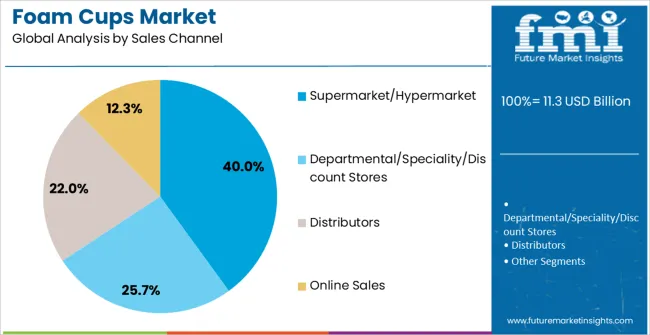
The Supermarket/Hypermarket sales channel segment is expected to account for 40.0% of the Foam Cups market revenue in 2025, making it the leading distribution channel. Growth is being driven by the increasing availability of foam cups in retail outlets, which allows consumers to conveniently purchase for home or office use. The channel benefits from wide reach, efficient supply chains, and strong promotional activities that enhance product visibility and accessibility.
The expansion of large-format stores and convenience sections within supermarkets has facilitated impulse purchases and bulk buying of foam cups. Additionally, retail channels provide opportunities for bundling and private label offerings, further encouraging consumer uptake.
The segment’s growth is reinforced by urbanization trends, rising disposable income, and the increasing popularity of at-home beverage consumption As retail networks continue to expand and consumer convenience remains a priority, the supermarket and hypermarket channel is expected to maintain its leadership in distributing foam cups across global markets.
Evolving packaging market with the introduction of new packaging solutions for the growing food and beverages industry is encouraging packaging manufacturers to develop aesthetic and innovative solutions. The use of disposable cups is increasing in the global food & beverages packaging market owing to increased consumption by food service providers, households, and institutions.
The disposable cups such as paper, plastic, and foam cups are maintaining their prominence in the global food packaging market due to its economy and easy availability. The foam cups keep beverages at their serving temperature inside and outside for a long time, due to which they are ideal for both hot and cold beverages.
The adoption of foam cups is decreasing over the time due to non-biodegradable and nearly impossible to recycling. The environment-friendly paper and fiber-based cups are taking the place of foam cups in the food services and retail stores.
Recently, the giant food service providers from United States, such as Dunkin' Donuts and McDonald's, are looking forward to completely stop using foam cups till 2025. New York, the United States’ largest city, has banned foam cups and containers made up from expanded polystyrene (EPS) from the start of 2025.
The key players in the foam cups market are engaging in the research and development to overcome the drawback of foam cups and provide eco-friendly solutions to the end-users.
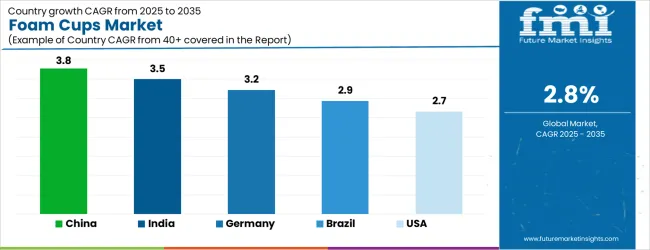
| Country | CAGR |
|---|---|
| China | 3.8% |
| India | 3.5% |
| Germany | 3.2% |
| Brazil | 2.9% |
| USA | 2.7% |
| UK | 2.4% |
| Japan | 2.1% |
The Foam Cups Market is expected to register a CAGR of 2.8% during the forecast period, exhibiting varied country level momentum. China leads with the highest CAGR of 3.8%, followed by India at 3.5%. Developed markets such as Germany, France, and the UK continue to expand steadily, while the USA is likely to grow at consistent rates. Japan posts the lowest CAGR at 2.1%, yet still underscores a broadly positive trajectory for the global Foam Cups Market.
In 2024, Germany held a dominant revenue in the Western Europe market and is expected to grow with a CAGR of 3.2%. The USA Foam Cups Market is estimated to be valued at USD 4.0 billion in 2025 and is anticipated to reach a valuation of USD 4.0 billion by 2035. Sales are projected to rise at a CAGR of 0.0% over the forecast period between 2025 and 2035. While Japan and South Korea markets are estimated to be valued at USD 529.4 million and USD 283.0 million respectively in 2025.
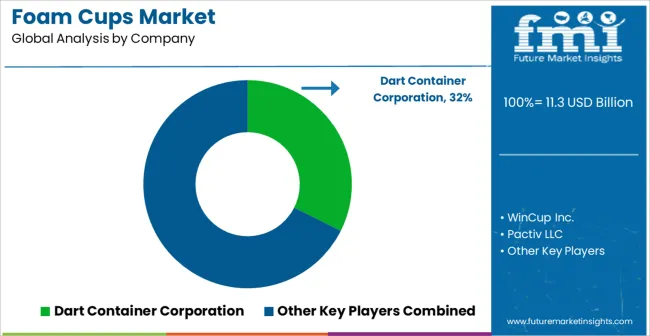
| Item | Value |
|---|---|
| Quantitative Units | USD 11.3 Billion |
| Size | Up To 10 Oz, 10 To 16 Oz, 16 To 20 Oz, 20 To 32 Oz, and More Than 32 Oz |
| Cup Type | Hot Cup Type and Cold Cup Type |
| Sales Channel | Supermarket/Hypermarket, Departmental/Speciality/Discount Stores, Distributors, and Online Sales |
| End User | Foodservice, Institutional, Household, and Catering Services |
| Regions Covered | North America, Europe, Asia-Pacific, Latin America, Middle East & Africa |
| Country Covered | United States, Canada, Germany, France, United Kingdom, China, Japan, India, Brazil, South Africa |
| Key Companies Profiled | Dart Container Corporation, WinCup Inc., Pactiv LLC, Genpak, LLC, Huhtamaki Group, Placon Corporation, Anchor Packaging, Inc., and Novolex Holdings, Inc. |
The global foam cups market is estimated to be valued at USD 11.3 billion in 2025.
The market size for the foam cups market is projected to reach USD 14.9 billion by 2035.
The foam cups market is expected to grow at a 2.8% CAGR between 2025 and 2035.
The key product types in foam cups market are up to 10 oz, 10 to 16 oz, 16 to 20 oz, 20 to 32 oz and more than 32 oz.
In terms of cup type, hot cup type segment to command 60.0% share in the foam cups market in 2025.






Our Research Products

The "Full Research Suite" delivers actionable market intel, deep dives on markets or technologies, so clients act faster, cut risk, and unlock growth.

The Leaderboard benchmarks and ranks top vendors, classifying them as Established Leaders, Leading Challengers, or Disruptors & Challengers.

Locates where complements amplify value and substitutes erode it, forecasting net impact by horizon

We deliver granular, decision-grade intel: market sizing, 5-year forecasts, pricing, adoption, usage, revenue, and operational KPIs—plus competitor tracking, regulation, and value chains—across 60 countries broadly.

Spot the shifts before they hit your P&L. We track inflection points, adoption curves, pricing moves, and ecosystem plays to show where demand is heading, why it is changing, and what to do next across high-growth markets and disruptive tech

Real-time reads of user behavior. We track shifting priorities, perceptions of today’s and next-gen services, and provider experience, then pace how fast tech moves from trial to adoption, blending buyer, consumer, and channel inputs with social signals (#WhySwitch, #UX).

Partner with our analyst team to build a custom report designed around your business priorities. From analysing market trends to assessing competitors or crafting bespoke datasets, we tailor insights to your needs.
Supplier Intelligence
Discovery & Profiling
Capacity & Footprint
Performance & Risk
Compliance & Governance
Commercial Readiness
Who Supplies Whom
Scorecards & Shortlists
Playbooks & Docs
Category Intelligence
Definition & Scope
Demand & Use Cases
Cost Drivers
Market Structure
Supply Chain Map
Trade & Policy
Operating Norms
Deliverables
Buyer Intelligence
Account Basics
Spend & Scope
Procurement Model
Vendor Requirements
Terms & Policies
Entry Strategy
Pain Points & Triggers
Outputs
Pricing Analysis
Benchmarks
Trends
Should-Cost
Indexation
Landed Cost
Commercial Terms
Deliverables
Brand Analysis
Positioning & Value Prop
Share & Presence
Customer Evidence
Go-to-Market
Digital & Reputation
Compliance & Trust
KPIs & Gaps
Outputs
Full Research Suite comprises of:
Market outlook & trends analysis
Interviews & case studies
Strategic recommendations
Vendor profiles & capabilities analysis
5-year forecasts
8 regions and 60+ country-level data splits
Market segment data splits
12 months of continuous data updates
DELIVERED AS:
PDF EXCEL ONLINE
Foam Type Vacuum Gripping System Market Size and Share Forecast Outlook 2025 to 2035
Foam Mixing Machine Market Size and Share Forecast Outlook 2025 to 2035
Foam Market Size and Share Forecast Outlook 2025 to 2035
Foam-Free Pad Formers Market Size and Share Forecast Outlook 2025 to 2035
Foam Bottle Technology Market Size and Share Forecast Outlook 2025 to 2035
Foaming Agents Market Size and Share Forecast Outlook 2025 to 2035
Foam Glass Granulate Market Size and Share Forecast Outlook 2025 to 2035
Foam Plastics Market Size and Share Forecast Outlook 2025 to 2035
Foaming Creamer Market Size and Share Forecast Outlook 2025 to 2035
Foam Tape Market Size and Share Forecast Outlook 2025 to 2035
Foam Glass Market Size and Share Forecast Outlook 2025 to 2035
Foamer Pump Market Size, Share & Forecast 2025 to 2035
Foam Food Container Market Size and Share Forecast Outlook 2025 to 2035
Foam Mesh Sleeves Market Growth - Demand & Forecast 2025 to 2035
Foam Edge Protectors Market Size and Share Forecast Outlook 2025 to 2035
Foamer Bottle Market Size and Share Forecast Outlook 2025 to 2035
Foam Cap Liners Market Size and Share Forecast Outlook 2025 to 2035
Foam Pouch Market Analysis - Demand, Size & Industry Outlook 2025 to 2035
Foam Cooler Box Market Analysis - Growth & Trends 2025 to 2035
Foam Packaging Inserts Market Analysis, Size, Share & Forecast 2025 to 2035

Thank you!
You will receive an email from our Business Development Manager. Please be sure to check your SPAM/JUNK folder too.
Chat With
MaRIA